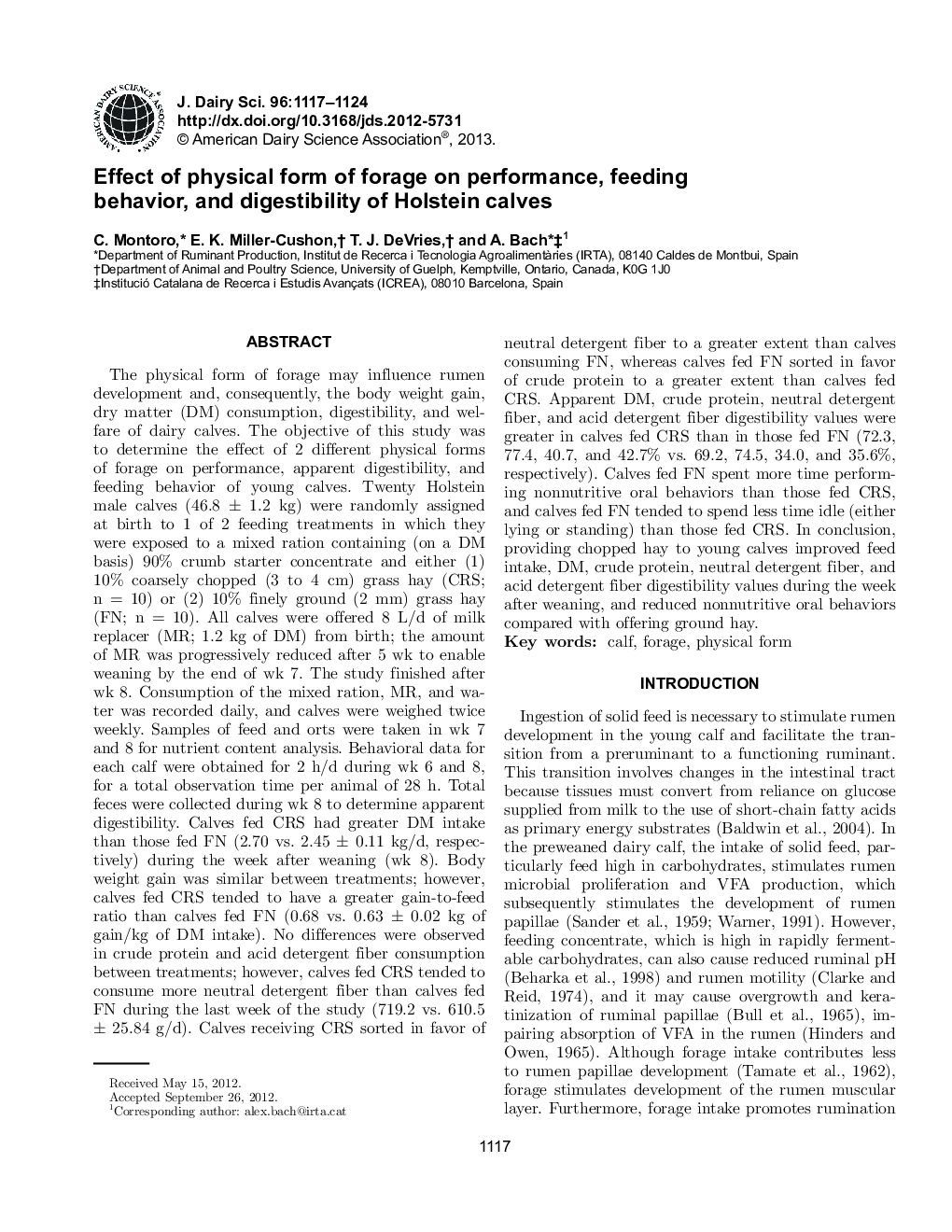| Article ID | Journal | Published Year | Pages | File Type |
|---|---|---|---|---|
| 10979955 | Journal of Dairy Science | 2013 | 8 Pages |
Abstract
The physical form of forage may influence rumen development and, consequently, the body weight gain, dry matter (DM) consumption, digestibility, and welfare of dairy calves. The objective of this study was to determine the effect of 2 different physical forms of forage on performance, apparent digestibility, and feeding behavior of young calves. Twenty Holstein male calves (46.8 ± 1.2 kg) were randomly assigned at birth to 1 of 2 feeding treatments in which they were exposed to a mixed ration containing (on a DM basis) 90% crumb starter concentrate and either (1) 10% coarsely chopped (3 to 4 cm) grass hay (CRS; n = 10) or (2) 10% finely ground (2 mm) grass hay (FN; n = 10). All calves were offered 8 L/d of milk replacer (MR; 1.2 kg of DM) from birth; the amount of MR was progressively reduced after 5 wk to enable weaning by the end of wk 7. The study finished after wk 8. Consumption of the mixed ration, MR, and water was recorded daily, and calves were weighed twice weekly. Samples of feed and orts were taken in wk 7 and 8 for nutrient content analysis. Behavioral data for each calf were obtained for 2 h/d during wk 6 and 8, for a total observation time per animal of 28 h. Total feces were collected during wk 8 to determine apparent digestibility. Calves fed CRS had greater DM intake than those fed FN (2.70 vs. 2.45 ± 0.11 kg/d, respectively) during the week after weaning (wk 8). Body weight gain was similar between treatments; however, calves fed CRS tended to have a greater gain-to-feed ratio than calves fed FN (0.68 vs. 0.63 ± 0.02 kg of gain/kg of DM intake). No differences were observed in crude protein and acid detergent fiber consumption between treatments; however, calves fed CRS tended to consume more neutral detergent fiber than calves fed FN during the last week of the study (719.2 vs. 610.5 ± 25.84 g/d). Calves receiving CRS sorted in favor of neutral detergent fiber to a greater extent than calves consuming FN, whereas calves fed FN sorted in favor of crude protein to a greater extent than calves fed CRS. Apparent DM, crude protein, neutral detergent fiber, and acid detergent fiber digestibility values were greater in calves fed CRS than in those fed FN (72.3, 77.4, 40.7, and 42.7% vs. 69.2, 74.5, 34.0, and 35.6%, respectively). Calves fed FN spent more time performing nonnutritive oral behaviors than those fed CRS, and calves fed FN tended to spend less time idle (either lying or standing) than those fed CRS. In conclusion, providing chopped hay to young calves improved feed intake, DM, crude protein, neutral detergent fiber, and acid detergent fiber digestibility values during the week after weaning, and reduced nonnutritive oral behaviors compared with offering ground hay.
Keywords
Related Topics
Life Sciences
Agricultural and Biological Sciences
Animal Science and Zoology
Authors
C. Montoro, E.K. Miller-Cushon, T.J. DeVries, A. Bach,
